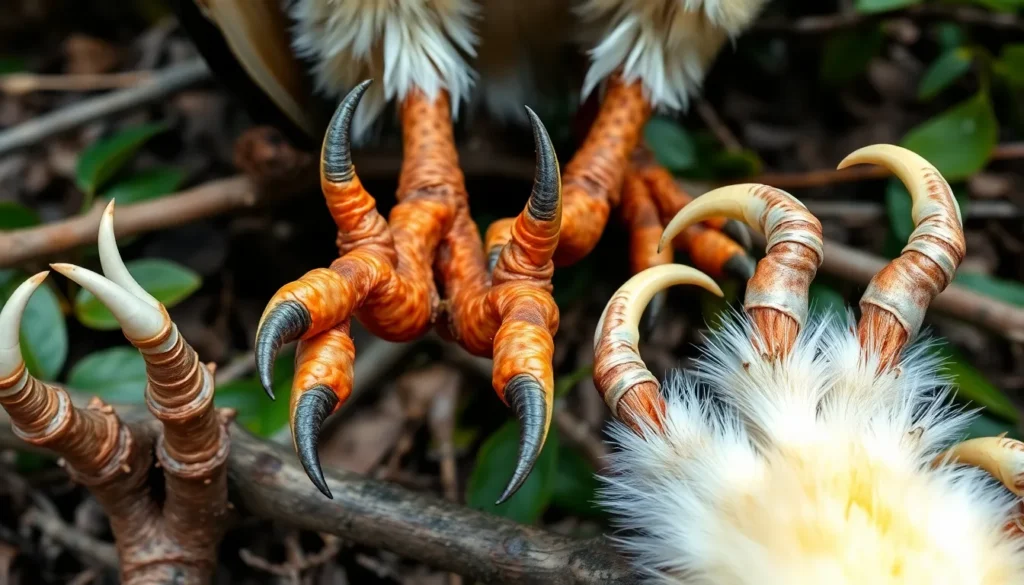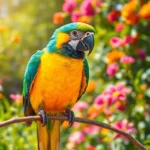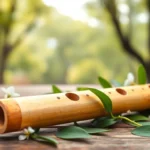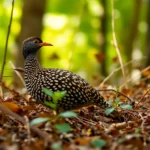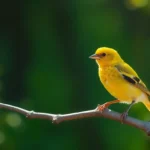We’ve all watched birds perch effortlessly on branches or witnessed raptors snatch prey with lightning-fast precision. Behind these impressive feats lie some of nature’s most sophisticated tools: bird claws. These remarkable appendages aren’t just simple hooks – they’re evolutionary masterpieces that have shaped how birds hunt, climb, swim, and survive across every habitat on Earth.
From the razor-sharp talons of eagles that can exert crushing force to the delicate curved claws of hummingbirds that grip the thinnest twigs, each species has developed unique claw designs perfectly matched to their lifestyle. Understanding how these incredible structures work reveals fascinating insights into bird behavior and evolution.
Whether you’re a birdwatcher curious about what you’re observing or simply fascinated by nature’s engineering, we’ll explore the amazing industry of bird claws and discover why they’re far more complex and interesting than you might expect.
What Are Bird Claws and Their Basic Structure
Bird claws represent specialized keratin structures that extend from the terminal bones of avian digits. We observe these curved appendages functioning as essential tools for grasping, perching, and manipulating objects in the bird’s environment.
Each bird claw consists of three primary components that work together to create its distinctive functionality. The ungual bone forms the internal skeletal support structure, providing the rigid framework necessary for strength and stability. Keratin sheaths cover this bone completely, creating the hard outer surface that contacts environmental elements during use. Blood vessels and nerve endings run through the quick, supplying nutrients and sensory feedback to maintain claw health and sensitivity.
Bird species demonstrate remarkable diversity in claw architecture based on their ecological requirements. Raptors like hawks and eagles possess sharp, curved talons measuring 1-4 inches in length for capturing and killing prey. Perching birds such as songbirds feature moderately curved claws approximately 0.25-0.5 inches long for gripping branches securely. Waterfowl including ducks and geese display shorter, blunter claws averaging 0.5-1 inch in length for walking on soft surfaces and swimming.
The growth pattern of bird claws follows continuous development throughout the bird’s lifetime. Keratin layers accumulate at the base of each claw, pushing older material toward the tip where natural wear occurs through daily activities. Most bird species maintain optimal claw length through this balance of growth and natural abrasion against perches, prey, and environmental surfaces.
Anatomical variations in claw curvature directly correlate with hunting and lifestyle behaviors. Straight claws appear in ground-dwelling species like chickens and pheasants for scratching and digging in soil. Highly curved claws characterize tree-climbing birds such as woodpeckers and nuthatches for enhanced grip on vertical bark surfaces. Semi-curved claws serve generalist species that require versatility across multiple habitats and feeding strategies.
Types of Bird Claws Based on Lifestyle and Habitat
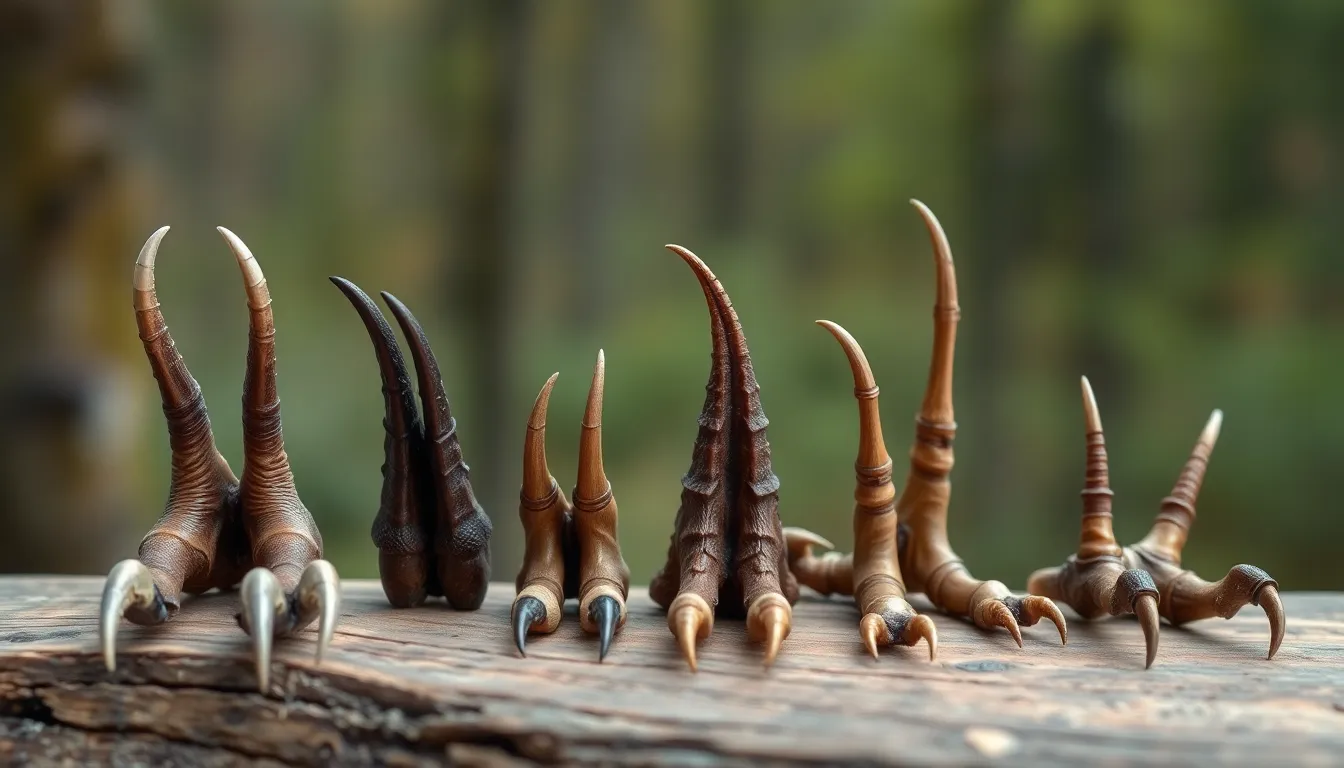
Bird claw adaptations demonstrate remarkable specialization across different ecological niches and behavioral requirements. These structural modifications reflect millions of years of evolutionary pressure that shaped each species’ survival strategies.
Raptors and Birds of Prey
Raptors possess the most formidable claw structures in the avian industry, featuring razor-sharp talons designed for killing and dismembering prey. These predatory birds showcase curved claws measuring 1-4 inches in length, with the hallux (rear toe) typically being the largest and most powerful. Eagles display massive talons capable of exerting 400-750 pounds per square inch of pressure, while smaller hawks and falcons generate 50-200 PSI through their proportionally sharp claws. The curvature angle in raptor claws ranges from 60-90 degrees, creating perfect hooks for penetrating and gripping struggling prey.
Owls feature uniquely reversible outer toes that rotate backward, providing a powerful four-point grip configuration for silent strikes. Falcon claws incorporate a distinctive notch called a “tomial tooth” that works along with their beaks to sever vertebrae efficiently. Osprey talons contain specialized scales on their undersides that prevent slippery fish from escaping their grasp.
Perching Birds and Songbirds
Songbirds and perching species evolved claws optimized for gripping cylindrical branches and maintaining balance during extended roosting periods. These birds feature moderately curved claws with angles typically measuring 30-45 degrees, providing sufficient grip without hindering quick takeoffs. Passerine claws measure 0.25-0.75 inches in most species, with proportional scaling based on body weight and preferred perching surfaces.
Cardinals and finches showcase relatively thick, blunt-tipped claws suitable for seed manipulation and branch gripping. Warblers possess finer, more delicate claws that enable precise movement through dense foliage without becoming entangled. Thrushes display slightly longer claws on their hind toes, facilitating ground foraging behaviors while maintaining perching capabilities.
Climbing Birds
Climbing specialists exhibit highly specialized claw configurations that vary dramatically based on their preferred vertical surfaces. Woodpeckers possess extremely curved claws with angles reaching 90-120 degrees, accompanied by reinforced shafts capable of supporting their entire body weight during vertical climbing. These claws measure 0.5-1.5 inches and feature exceptionally sharp points that penetrate bark effectively.
Nuthatches showcase shorter but incredibly strong claws designed for headfirst descent navigation on tree trunks. Their claws maintain constant contact with bark surfaces through specialized muscle control systems. Treecreepers evolved longer rear claws that function as anchors while their shorter front claws provide forward grip during spiral climbing patterns.
Aquatic and Wading Birds
Aquatic birds developed claw adaptations that balance terrestrial mobility with swimming efficiency and specialized feeding behaviors. Waterfowl feature shorter, blunter claws measuring 0.25-0.5 inches that minimize drag during swimming while providing adequate traction on muddy shorelines. Ducks and geese showcase slightly flattened claw profiles that function effectively on both soft sediments and rocky surfaces.
Wading birds like herons and egrets possess elongated toes with correspondingly longer claws that distribute weight across soft substrates, preventing them from sinking into mud. Shorebirds exhibit varying claw lengths correlating with their foraging depth preferences, with deeper probers having longer claws for substrate manipulation. Cormorants and other diving species maintain streamlined claw profiles that reduce water resistance during underwater pursuit of fish.
Anatomy and Composition of Bird Claws
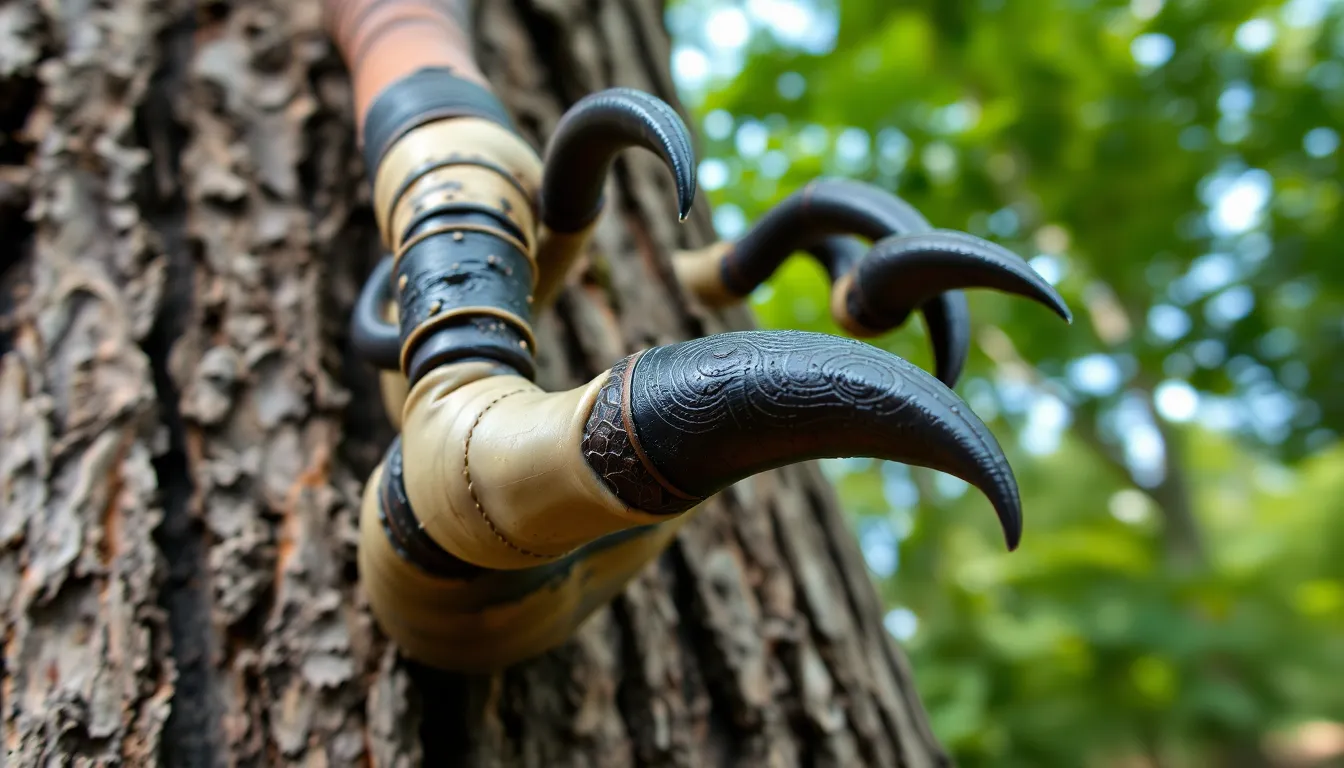
Bird claws consist of three fundamental anatomical components that work together to create these remarkable structures. The ungual bone forms the internal framework, providing rigid support for the entire claw structure while maintaining proper shape during use. Keratin sheaths surround this bone core, creating the hard external surface that contacts prey, branches, and substrate materials.
Blood vessels and nerve endings penetrate throughout the claw structure, supplying essential nutrients for growth and providing tactile feedback during hunting and perching activities. These vascular networks concentrate near the base of each claw, where new keratin production occurs continuously throughout a bird’s lifetime.
Internal Structure Components
The ungual bone represents the terminal phalanx of each digit, extending from the bird’s toe bones to form the claw’s skeletal foundation. This specialized bone features a curved morphology in most species, with the degree of curvature varying significantly based on ecological requirements.
Keratin layers accumulate in distinct patterns around the ungual bone, forming concentric growth rings similar to tree rings. These layers develop from the germinal matrix located at the claw’s base, where specialized cells produce new keratin material at rates of 0.1 to 0.3 millimeters per week depending on species.
| Component | Function | Growth Rate | Composition |
|---|---|---|---|
| Ungual Bone | Structural support | Fixed after maturity | Calcium phosphate |
| Keratin Sheath | Protection and grip | 0.1-0.3 mm/week | Alpha-keratin proteins |
| Vascular Network | Nutrition and sensation | Continuous renewal | Blood vessels and nerves |
Keratin Composition Analysis
Alpha-keratin proteins form the primary structural component of bird claws, arranged in tightly packed fibrous bundles that provide exceptional strength. These proteins contain high concentrations of cysteine amino acids, which create disulfide bonds that enhance the material’s durability and resistance to wear.
The keratin matrix incorporates calcium carbonate deposits in many species, particularly those that use their claws for digging or aggressive prey capture. Raptors demonstrate the highest calcium content in their talons, with concentrations reaching 15-20% of total claw mass in large eagles and hawks.
Melanin pigments distribute throughout the keratin structure, creating the dark coloration observed in most bird claws while simultaneously increasing hardness. Birds with heavily pigmented claws show 23% greater resistance to fracture compared to those with lighter colored claws.
Growth and Maintenance Mechanisms
Claw growth occurs through continuous keratinization at the proximal end, where new material pushes older layers toward the tip. This process maintains optimal claw length through natural wear patterns during daily activities like perching, walking, and prey capture.
Environmental factors influence growth rates significantly, with birds in captivity often requiring regular claw trimming due to reduced natural wear. Wild birds naturally maintain proper claw length through contact with rough surfaces including tree bark, rocks, and prey items.
The growth rate varies seasonally in many species, accelerating during breeding periods when increased hormone levels stimulate keratin production. Arctic birds show particularly pronounced seasonal variation, with winter growth rates 40% higher than summer rates to compensate for increased wear on frozen surfaces.
Functions and Uses of Bird Claws in Daily Life
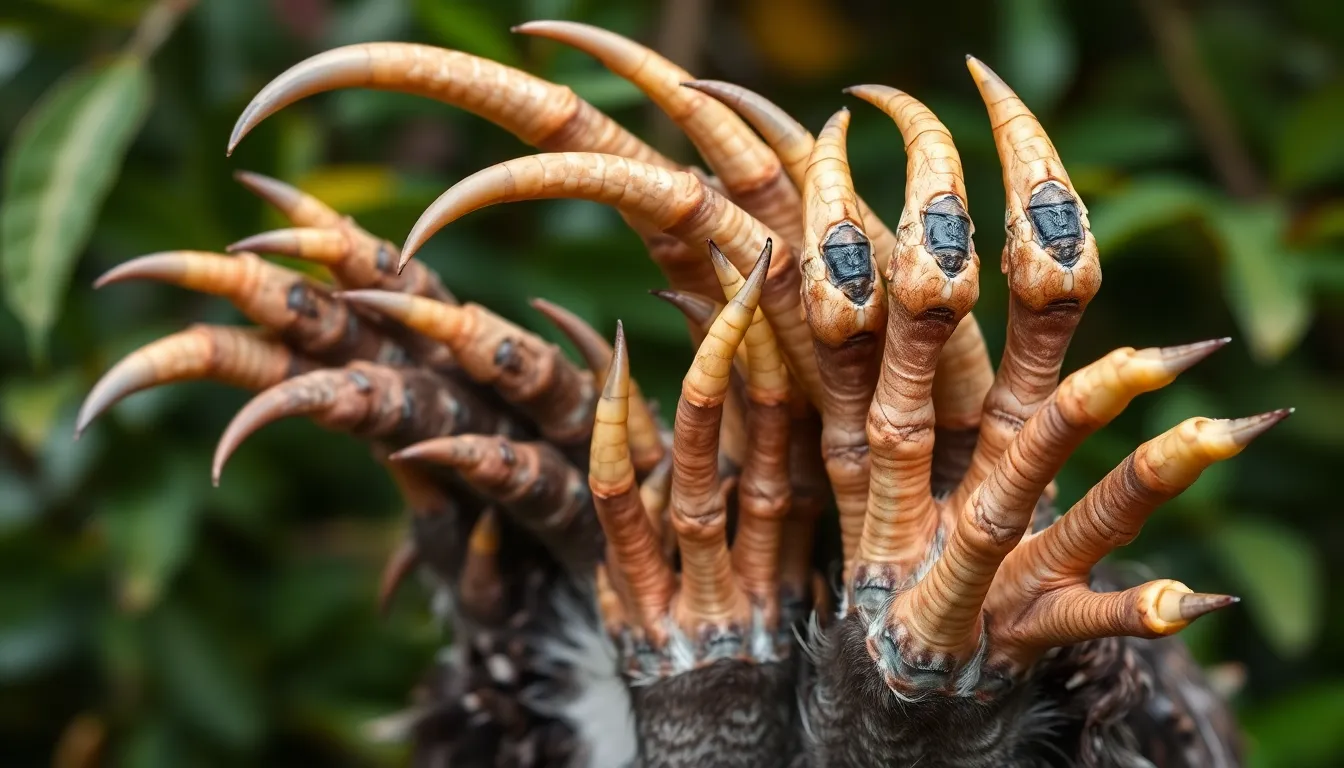
Bird claws serve multiple essential functions beyond their anatomical complexity, enabling species-exact behaviors that determine survival success. These keratin structures help four primary activities that define avian existence across diverse habitats.
Hunting and Capturing Prey
Raptors demonstrate the most specialized hunting applications of bird claws, with eagles exerting up to 750 pounds per square inch of pressure through their talons. Hawks employ their curved claws in coordinated strikes, piercing vital organs of prey animals within milliseconds of contact. Owls use asymmetrical claw placement to maintain silent approaches, with their sharp talons penetrating small mammal skulls efficiently.
Fishing birds like ospreys feature reversible outer toes and specialized scaling on claw undersurfaces that prevent slippery fish from escaping. Herons employ patient stalking techniques, using their straight, dagger-like claws to spear fish and amphibians in shallow water. Kingfishers dive at speeds reaching 25 miles per hour, relying on their pointed claws to secure aquatic prey during rapid underwater captures.
Gripping and Perching
Perching birds execute automatic locking mechanisms through their flexor tendons, allowing sustained branch grip without conscious muscle effort. Songbirds maintain 360-degree rotation capabilities around cylindrical branches using their opposable hind toe arrangements. Woodpeckers employ their zygodactyl claw configuration with two forward-facing and two backward-facing toes to achieve vertical surface navigation.
Climbing species like nuthatches descend tree trunks headfirst by rotating their hind claws 180 degrees for enhanced grip security. Parrots use their claws as manipulative appendages, grasping food items and tools with precision comparable to primate hands. Swifts possess permanent claw curvature that prevents terrestrial walking but enables exceptional aerial maneuverability and cliff-face clinging.
Defense and Protection
Territorial birds deploy their claws as primary weapons during aggressive encounters, with roosters inflicting serious injuries through their spur-enhanced hind claws. Ground-dwelling species like turkeys use their claws to create dust baths, removing parasites and maintaining feather condition through vigorous scratching motions. Cassowaries possess 5-inch dagger-like claws capable of delivering fatal kicks to potential predators.
Flocking birds coordinate defensive claw displays to intimidate larger threats, with starlings creating synchronized talon presentations during mobbing behaviors. Parent birds shield their young using extended claw postures, creating protective barriers around nesting sites. Arctic species sharpen their claws on ice surfaces, maintaining optimal edge geometry for emergency defensive situations.
Grooming and Maintenance
Preening activities require precise claw control for accessing difficult feather regions, particularly around the head and neck areas. Waterbirds use their claws to distribute preen gland oils across their plumage, ensuring waterproof integrity during aquatic activities. Scratching motions remove dead feather material and parasitic organisms that conventional beak preening cannot address.
Social species engage in mutual claw grooming behaviors, with pairs reaching areas inaccessible during individual maintenance sessions. Molting birds rely heavily on claw-assisted feather removal, accelerating the replacement of worn plumage components. Dust bathing involves coordinated claw and wing movements, creating fine particle clouds that suffocate external parasites and absorb excess oils from feather surfaces.
Evolutionary Adaptations of Bird Claws
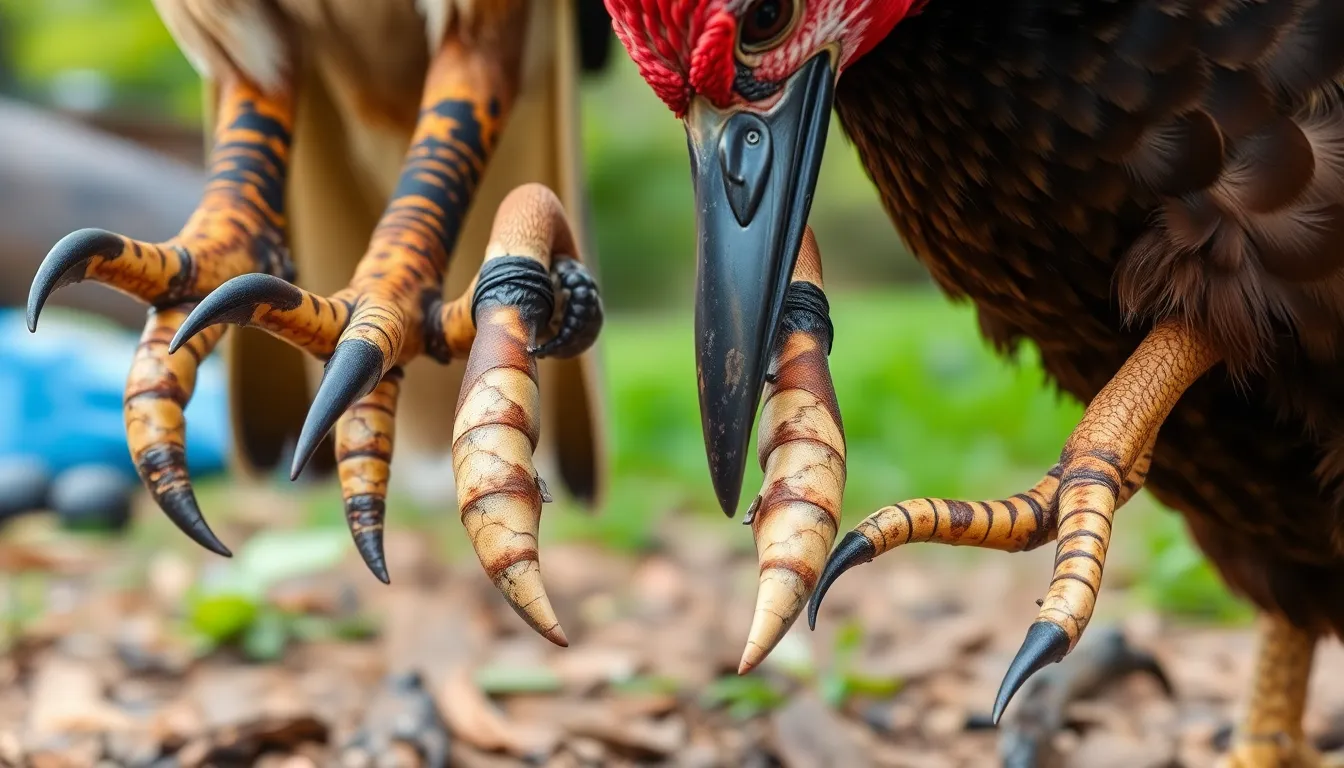
Evolutionary pressures shaped bird claws across millions of years, creating specialized appendages that match each species’ ecological niche perfectly. Natural selection favored individuals with claw configurations that enhanced survival rates in their exact environments.
Predatory birds developed sharp, curved talons through genetic mutations that improved hunting success rates. Raptors like peregrine falcons evolved talons capable of exerting 400-500 pounds of pressure per square inch, allowing them to pierce vital organs instantly. These evolutionary changes occurred over approximately 50 million years, with fossil evidence showing gradual increases in talon curvature and strength.
Arboreal species evolved different claw adaptations to maximize gripping efficiency on various bark textures and branch diameters. Woodpeckers developed zygodactyl feet with two forward-facing and two backward-facing claws, creating superior vertical climbing capabilities. Their claws grew 40% longer than ground-dwelling birds of similar body mass, providing enhanced anchoring power during foraging activities.
| Species Group | Claw Curvature | Pressure Capability | Primary Adaptation |
|---|---|---|---|
| Raptors | 60-90 degrees | 400-750 PSI | Prey capture |
| Woodpeckers | 45-70 degrees | 200-350 PSI | Vertical climbing |
| Songbirds | 30-50 degrees | 50-150 PSI | Branch perching |
| Waterfowl | 15-25 degrees | 25-75 PSI | Aquatic locomotion |
Aquatic birds underwent evolutionary modifications that balanced terrestrial mobility with swimming efficiency. Ducks and geese developed partially webbed feet with shorter, blunter claws that reduce drag underwater while maintaining adequate grip on muddy surfaces. Their claw keratin composition contains 15% more sulfur cross-links than terrestrial species, creating enhanced durability against constant moisture exposure.
Ground-dwelling birds evolved straight, robust claws optimized for scratching and digging behaviors. Chickens and pheasants possess claws with reinforced ungual bones that resist fractures during intensive ground foraging. These adaptations emerged through selective breeding pressures that favored individuals capable of accessing buried food sources efficiently.
Arctic species developed seasonal claw growth patterns that compensate for extreme environmental wear. Ptarmigan claws grow 30% faster during winter months, counteracting increased abrasion from frozen surfaces. Their keratin structure incorporates specialized proteins that maintain flexibility at temperatures below -40°F.
Climbing specialists evolved unique claw orientations that help both upward and downward movement on vertical surfaces. Nuthatches possess asymmetrical claw configurations, with their hind claws 25% longer than forward claws, enabling headfirst descent on tree trunks. This evolutionary adaptation required precise genetic coordination between bone growth, muscle attachment, and nerve pathway development.
Scavenging birds developed broad, sturdy claws that excel at manipulating carrion and defensive posturing. Vultures evolved claws with reduced curvature but increased surface area, optimizing grip on large carcasses rather than live prey capture. Their ungual bones contain 20% more calcium phosphate than predatory species, creating superior strength for tearing tough hide and sinew.
Care and Maintenance of Bird Claws in Captivity
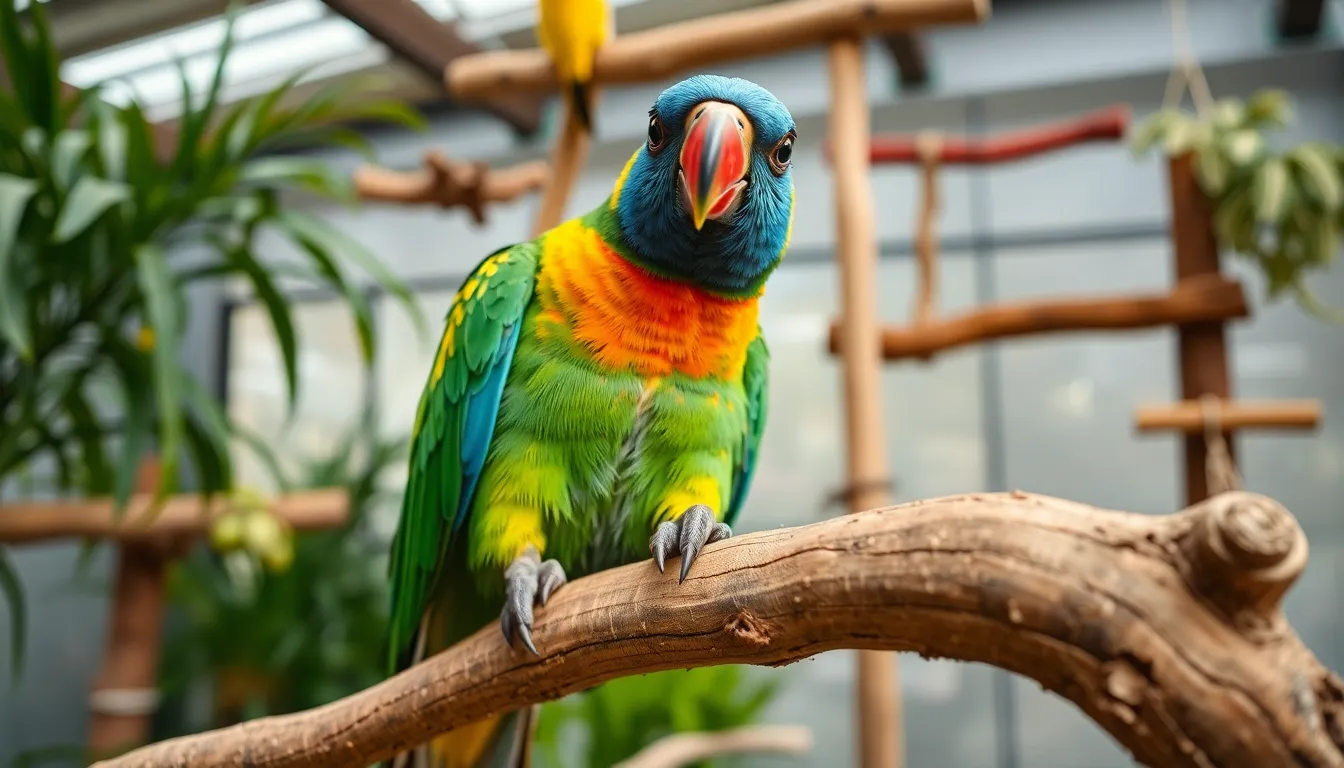
Captive birds require specialized attention to maintain healthy claw growth and prevent overgrowth complications that commonly affect domesticated avian species. Pet owners and aviculturists observe that captive environments lack the natural abrasive surfaces found in wild habitats, leading to accelerated keratin accumulation and potential health issues.
Regular claw trimming becomes essential when birds don’t naturally wear down their claws through perching on rough branches and foraging behaviors. Professional veterinarians recommend trimming sessions every 4-6 weeks for most captive bird species, though growth rates vary significantly based on diet, age, and species characteristics. Cockatoos and macaws typically require more frequent maintenance due to their robust keratin production rates, while smaller finches and canaries need less intensive care schedules.
Signs That Indicate Claw Trimming Requirements
Overgrown claws create mobility challenges and increase injury risks for captive birds across all species categories. Visual indicators include claws that curve excessively beyond natural angles, making perching difficult and uncomfortable for the bird. Length measurements exceeding 150% of normal proportions signal immediate trimming needs, particularly when claws begin catching on cage bars or fabric surfaces.
Behavioral changes often accompany overgrown claws, with birds showing reluctance to perch normally or displaying awkward gripping patterns. Walking difficulties become apparent when claws prevent proper foot placement, causing birds to favor certain perches or avoid ground feeding altogether. Split or damaged claw tips frequently result from excessive length, creating potential infection sites that require immediate veterinary attention.
Professional vs DIY Claw Trimming Approaches
Veterinary professionals possess specialized training to identify the quick (vascular portion) within each claw, preventing accidental bleeding and trauma during trimming procedures. Experienced avian veterinarians use pneumatic nail trimmers or specialized scissors designed for bird anatomy, ensuring precise cuts that maintain optimal claw functionality. Professional services typically cost $15-35 per session but provide safety guarantees and health assessments.
DIY trimming requires proper equipment including high-quality bird nail clippers, styptic powder for emergency bleeding control, and adequate lighting for quick identification. Bird owners can learn basic trimming techniques through veterinary demonstrations, though practice on less critical outer claw portions builds confidence before attempting complex procedures. Emergency preparation includes having towels for restraint, first aid supplies, and veterinary contact information readily accessible.
Environmental Modifications for Natural Claw Maintenance
Natural perch varieties provide essential abrasive surfaces that promote healthy claw wear in captive environments across different bird housing systems. Concrete perches offer effective grinding action for larger species like African greys and Amazon parrots, while sandpaper covers provide gentler abrasion for smaller species. Branch diameter variations ranging from 0.5-2 inches accommodate different foot sizes and encourage natural gripping behaviors.
Foraging opportunities stimulate natural scratching behaviors that contribute to claw maintenance through substrate interaction and food manipulation activities. Digging boxes filled with safe materials like shredded paper or coconut fiber encourage ground-dwelling behaviors in species like cockatiels and budgerigars. Climbing structures incorporating rope, wood, and metal components provide diverse textures that naturally file claws during daily activities.
Diet and Nutrition Impact on Claw Health
Protein intake directly affects keratin production rates and overall claw strength in captive bird populations across species categories. High-quality pellet diets containing balanced amino acid profiles support healthy claw growth, while seed-only diets often result in brittle, weak claws prone to splitting. Supplementation with biotin and zinc improves keratin quality, particularly beneficial for molting birds experiencing increased nutritional demands.
Vitamin A deficiency commonly manifests in poor claw quality, with affected birds showing slow growth rates and increased susceptibility to infections. Fresh vegetables containing beta-carotene, including carrots, sweet potatoes, and leafy greens, provide essential nutrients for keratin synthesis. Calcium supplementation supports the ungual bone structure, particularly important for egg-laying females experiencing increased mineral demands.
Common Health Problems and Prevention Strategies
Bacterial infections frequently develop in overgrown or damaged claws, particularly when birds scratch excessively due to skin irritation or parasitic infestations. Fungal growth thrives in moist environments around the claw base, especially problematic in humid climates or poorly ventilated housing conditions. Preventive measures include maintaining dry perching areas and regular foot inspections for early problem detection.
Ingrown claws occur when overgrowth causes curvature into the foot pad, creating painful pressure points and potential puncture wounds. Regular monitoring prevents this condition through timely trimming interventions and proper perch selection that encourages natural wear patterns. Fractures result from trauma or excessive length creating leverage points during normal activities, requiring immediate veterinary intervention to prevent permanent damage.
Common Problems and Disorders Affecting Bird Claws
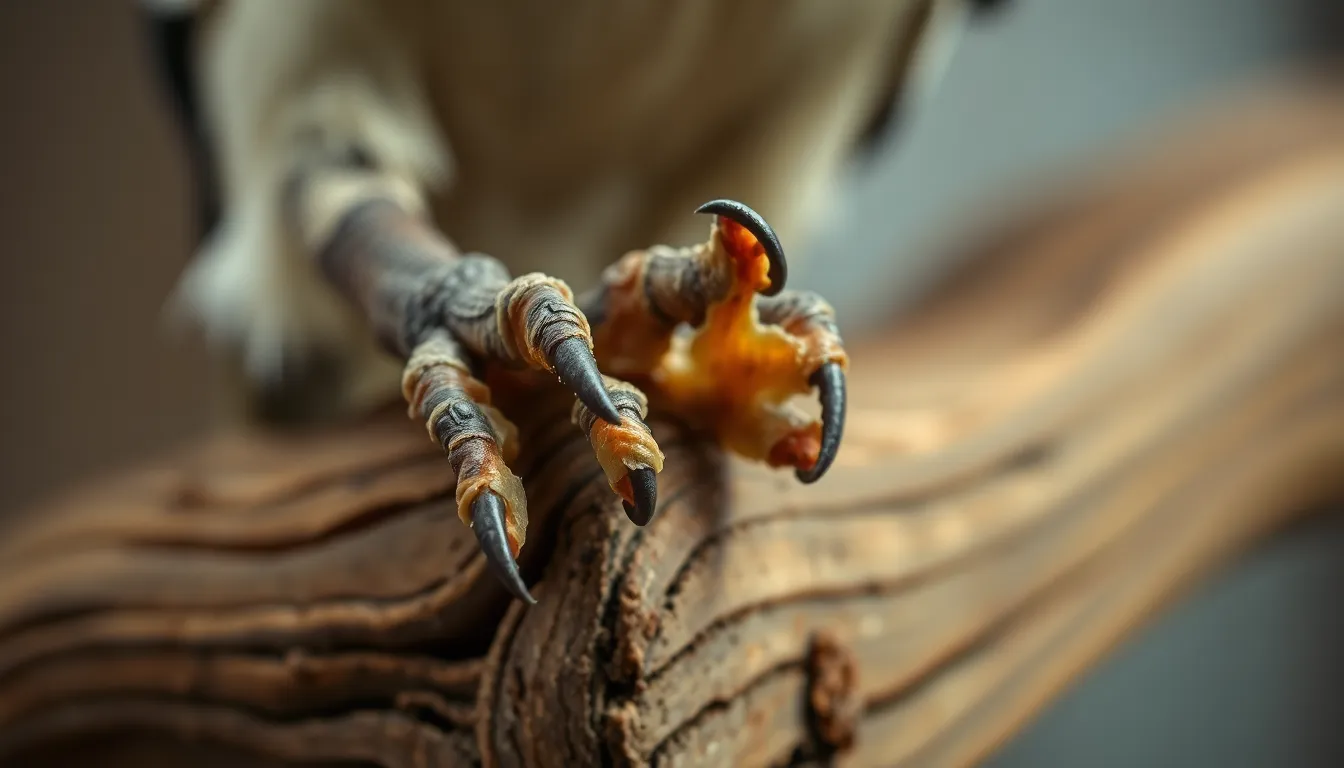
Common problems and disorders affecting bird claws manifest through various pathological conditions that compromise claw health and functionality. Overgrowth represents the most frequent issue in captive birds, occurring when natural wear mechanisms fail to maintain proper keratin length. Bacterial infections develop when moisture accumulates around the claw base, creating ideal conditions for pathogenic organisms like Staphylococcus and Streptococcus species.
Fungal infections attack the keratin structure directly, causing brittleness and discoloration that weakens the overall claw integrity. Bumblefoot, a bacterial infection of the plantar surface, affects the proximal claw region and causes important mobility impairment. Trauma-related injuries include fractures of the ungual bone, torn keratin sheaths, and complete claw avulsion during territorial disputes or accidents.
| Disorder Type | Primary Symptoms | Affected Species | Treatment Duration |
|---|---|---|---|
| Overgrowth | Excessive curvature, perching difficulty | Captive parrots, finches | 2-3 weeks |
| Bacterial infection | Swelling, discharge, lameness | Waterfowl, raptors | 7-14 days |
| Fungal infection | Brittle texture, discoloration | Tropical species | 4-6 weeks |
| Bumblefoot | Plantar swelling, reluctance to perch | Chickens, hawks | 2-4 weeks |
| Traumatic injury | Bleeding, partial amputation | All species | Variable |
Nutritional deficiencies create systemic problems that manifest in claw abnormalities, particularly protein deficiency which affects keratin synthesis rates. Vitamin A deficiency compromises the integrity of epithelial tissues surrounding the claw matrix, leading to poor growth quality. Metabolic disorders like liver disease alter protein metabolism, resulting in weak and malformed claw structures.
Genetic abnormalities produce congenital deformities such as polydactyly, where birds develop extra digits, or brachydactyly, characterized by abnormally short claws. Age-related changes affect elderly birds through decreased blood circulation to the extremities, causing slow healing and increased susceptibility to infections. Arthritis in the digital joints creates mobility restrictions that prevent normal claw maintenance behaviors.
Environmental factors contribute significantly to claw disorders, with inappropriate perching surfaces causing either excessive wear or insufficient abrasion. Temperature extremes damage the vascular network within claws, particularly in Arctic species exposed to rapid temperature fluctuations. Parasitic infestations, including mites and lice, irritate the skin around claws and create secondary bacterial infections through scratching behaviors.
Chemical exposure from cleaning agents or pesticides causes contact dermatitis that spreads to claw tissues, resulting in inflammation and tissue death. Autoimmune conditions trigger the bird’s immune system to attack healthy claw tissues, producing chronic inflammation and progressive degeneration. Hormonal imbalances during breeding seasons can accelerate or decelerate claw growth rates, creating management challenges in captive settings.
Stress-related disorders manifest through repetitive behaviors like excessive scratching or claw-biting, which damage the keratin structure and create entry points for pathogens. Improper trimming techniques cause splitting, bleeding, and increased infection risk when performed without adequate knowledge of claw anatomy. Cage design flaws, including wire spacing that traps claws or inappropriate substrate materials, contribute to mechanical injuries and chronic irritation.
Conclusion
Bird claws stand as remarkable examples of nature’s precision engineering with each species developing unique adaptations that perfectly match their ecological needs. From the razor-sharp talons of hunting raptors to the delicate gripping claws of songbirds these specialized structures demonstrate millions of years of evolutionary refinement.
Understanding the complexity behind these seemingly simple appendages helps us appreciate the intricate relationships between form and function in the avian industry. Whether we’re observing wild birds or caring for captive species recognizing the importance of healthy claw maintenance ensures these incredible tools continue to serve their vital purposes.
The next time we watch a hawk strike its prey or see a woodpecker scale a tree trunk we’ll know we’re witnessing evolutionary masterpieces at work.
Frequently Asked Questions
What are bird claws made of?
Bird claws are specialized structures made primarily of keratin, the same protein found in human fingernails. They consist of three main components: the ungual bone that provides structural support, hard keratin sheaths that form the outer surface, and blood vessels with nerve endings that supply nutrients and sensory feedback for optimal claw health and functionality.
How do bird claws grow?
Bird claws grow continuously through a process called keratinization, where new keratin layers accumulate at the base of the claw. This constant growth compensates for natural wear from daily activities like perching, hunting, and climbing. Environmental factors and seasonal changes can influence growth rates, particularly in Arctic species that experience accelerated winter growth.
Why do different bird species have different claw shapes?
Claw shapes reflect millions of years of evolutionary adaptation to specific lifestyles and habitats. Raptors have sharp, curved talons for hunting prey, while perching birds have moderately curved claws for gripping branches. Ground-dwelling birds possess straighter claws for scratching, and climbing species like woodpeckers have highly curved claws for vertical navigation.
How often should captive bird claws be trimmed?
Captive birds typically need professional claw trimming every 4-6 weeks, depending on the species. Unlike wild birds that naturally wear down their claws on various surfaces, captive birds often lack sufficient abrasive environments, leading to overgrowth. Signs of overgrown claws include excessive curvature, difficulty perching, and behavioral changes.
What functions do bird claws serve?
Bird claws serve multiple essential functions including hunting and capturing prey, gripping and perching on branches, defense against predators and territorial disputes, and grooming activities like preening feathers and removing parasites. These versatile tools are critical for survival across various bird behaviors and daily activities.
Can bird claws indicate health problems?
Yes, bird claws can reveal various health issues including bacterial and fungal infections, nutritional deficiencies, and trauma-related injuries. Common problems include overgrowth, ingrown claws, and changes in color or texture. Regular monitoring of claw condition, along with proper nutrition and environmental management, helps prevent these disorders.
What makes raptor claws different from other birds?
Raptor claws, called talons, are specifically designed for killing prey and feature sharp, highly curved structures that can exert tremendous pressure. They’re significantly larger and more powerful than claws of perching or ground-dwelling birds, with specialized anatomy that enables swift, lethal strikes during hunting. This adaptation makes them formidable predatory tools.
How do aquatic birds’ claws differ?
Aquatic and wading birds have shorter, blunter claws compared to terrestrial species. These adaptations balance mobility on land with swimming efficiency. Their claws are designed for walking on soft surfaces like mud and sand, while still providing adequate grip for perching and basic manipulation tasks without hindering their aquatic lifestyle.

